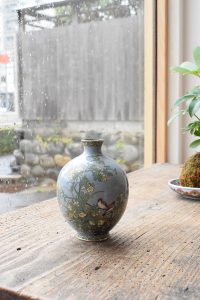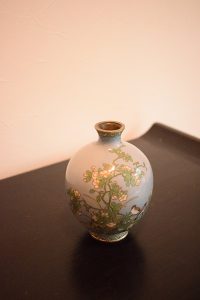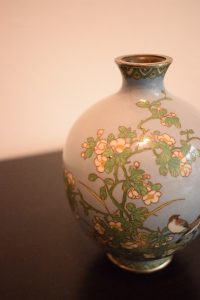梅雨入りいたしましたね(骨董買取致します。愛知県名古屋市千種区 古美術風光舎 名古屋店)
2021.05.19
みなさま、いかがお過ごしでしょうか。
スタッフYです。ここ古美術風光舎名古屋店のあります愛知県は、先日梅雨入りいたしました。もちろん、今朝から雨がしとしとと降っております。

ここ、東海地方は例年より21日も早い梅雨入りとのこと。こんなに早くの梅雨入りとは困りましたね…汗。洗濯物、カビ、崩れる髪の毛、濡れる足元、濡れた傘のあたる不快感、機嫌の悪い家族…。例年ならば「五月晴れ」となり、一年の中で老若男女一番開放感のある季節であったろうに。(本日は、ブログが荒れております)
梅雨に背を向けてはいけない(大袈裟な…)、「梅雨」に向き合っていると、「梅雨」という言葉の意外な歴史的経緯が見えてきました。
その前に、注視しなければならないのが「五月晴れ」という言葉です。初夏の晴れ渡った空ではなく梅雨(つゆ)の短い晴れ間を指す言葉だったようでして、梅雨は例年6月前後の曇りや雨の多い期間を意味するはずだが、なぜ「梅雨晴れ」でなく「五月晴れ」なのでしょうか。国語辞典をいくつか引いてみても、梅雨の晴れ間という意味と5月の晴れ渡った空という意味の両方を載せていて、五月晴れはもともと2つの意味が広く認められているようですね。

2通りの意味を持つようになった大きな理由が、明治時代に行われた改暦のようです。日本では、江戸時代までは「太陰太陽暦」という月の満ち欠けと太陽の周期の両方にあわせて作った暦が使われていたが、明治維新後、西洋の列強国と同じ「太陽暦」を使う必要に迫られ、旧暦の明治5年(1872年)12月3日を新暦の明治6年1月1日とする改暦したことは、皆さまご存じのことでしょう。
そのため、5月の指す時期が約1カ月前にずれてしまったというわけです。ただ梅雨が初夏の雨期を表す言葉として一般に使われるようになったのは、実は室町時代ごろからのこと。それ以前は「長雨(ながめ)」などと言っていたようですね。しかもこれは単に長く降り続く雨という意味であって、季節を限定した言い方ではないようで、シーズンとしての梅雨を表す言葉がなかったため、その月(5月)であるサツキとしか言いようがなかったということらしいです。
「つゆ」はもともと水滴を意味する言葉だったようで、それが、やがて比喩的に涙を表したり、「つゆけし」という形容詞形によって涙がちな様子や湿っぽいさまを表したりするようになっていきます。
そのように意味する範囲が拡大していく中で、湿りがちな夏の雨期も「つゆ」と呼ぶようになっていきました。雨期を表す「つゆ」という言葉は、江戸時代には定着したとみられ、当時の人は、湿りっぽい、涙がちな季節をそう名付けたんでしょうね、粋ですね。
ちなみに、各地方に「つゆ」と命名する以前の梅雨を表す言葉が残っています。
東北地方や沖縄には、「ナガアメ」「ナガメ」という言葉があるとされ、これらは「つゆ」と呼ぶようになる前の古い言い方の名残ではないかと考えられています。「梅雨」は漢語では「ばいう」と呼びますが、これ読み方は平安時代の漢詩集の中にも登場しております、やはり一般には広まっていなかったようでして、地方独自の表現のほうが残っているようですね。
冒頭に五月晴れという言葉を使いましたが、「五月」が付く言葉は、探してみると意外にたくさんあります。五月雨(さみだれ)、五月闇(さつきやみ)、五月空(さつきぞら)……。これらはすべて旧暦5月のことで梅雨と関係が深いのですが、昔は梅雨を表す言葉がなかったからなのでしょうか。「梅雨」(つゆ)の方が、後から作られた言葉とは。
ではなぜ、「梅雨」=(ばいう)=(つゆ) なんだろうという次なる疑問が発生。
これは諸説あるようですが、中国の長江流域では梅の実が熟す頃に降る雨を「梅雨(ばいう)」と呼んでいたという説、「黴(カビ)が生えやすい時期の雨」という意味で「黴雨(ばいう)」と呼んだ説、カビでは語感が良くないので同じ読みで季節に合った「梅」の字を使い「梅雨」になったという説、それらを日本では、「露(つゆ)」から連想したとか、梅の実が熟す時期だから「つはる」から連想したとか、梅の実が熟し潰れる時期だから「潰ゆ(つゆ)」と関連つけたとかななどの意味とからめて、「梅雨」(つゆ)としたのでしょうか。
どんな意味をからめても、洗濯物は乾かず、カビは知らぬ間にはえ、崩れる髪の毛にがっかりし、濡れる足元にげんなりし、濡れた傘のあたる不快感で萎え、機嫌の悪い家族はもう知らん…これらの改善は厳しそうですが、中国の方がこの嫌な長雨を梅の実を彷彿させるべくつけてくれた「梅雨」と、日本の方が長雨を奥ゆかしく「つゆ」とに名付けてくれたことに少し救われながら、しとしとと降り続く窓越しの雨を眺めています。

How are you all doing?
This is Staff Y. Aichi Prefecture, where the antique art Fukosha Nagoya store is located, has recently entered the rainy season. Of course, it has been raining since this morning.
Here, the Tokai region is said to have entered the rainy season 21 days earlier than usual. I didn’t want to get into the rain so early … sweat. Laundry, mold, crumbled hair, wet feet, discomfort from a wet umbrella, a family in a bad mood … It would have been “May sunny” every year, and it would have been the most open season for men and women of all ages. (Today, the blog is rough)
Don’t turn your back on the rainy season (exaggerated …), and when you face the rainy season, you can see the surprising historical background of the word “rainy season”.
Before that, the word “May sunny” must be watched. It seems that it was a term that refers to a short sunny season of the rainy season (tsuyu) rather than the clear sky of early summer, and the rainy season should mean a cloudy or rainy period around June every year, but why not “rainy season” but “rainy season” Is it sunny in May? Even if you look up some Japanese dictionaries, it lists both the meaning of the rainy season and the meaning of the clear sky in May, and it seems that the two meanings of May are originally widely recognized.
The main reason why it came to have two meanings seems to be the calendar reform that took place in the Meiji era. In Japan, until the Edo period, the “Lunisolar calendar” was used, which was created according to both the phases of the moon and the cycle of the sun, but after the Meiji Restoration, it was necessary to use the same “solar calendar” as the Western powers. As you all know, the calendar was changed from December 3, 1872, the lunar calendar, to January 1, 1872, the new calendar.
As a result, the time pointed to in May has shifted about a month ago. However, it was around the Muromachi period that the rainy season came to be commonly used as a term to describe the rainy season in early summer. Before that, it seems that you used to say “long rain”. Moreover, this simply means long-lasting rain, and it seems that it is not a seasonal term, and since there was no word to describe the rainy season as a season, it could only be called Satsuki, which is the month (May). It seems to be a thing.
It seems that “tsuyu” was originally a word meaning water droplets, and eventually it came to express tears figuratively, and the adjective form “tsuyu keshi” to express tear-prone appearance and dampness. To go.
As the range of meaning has expanded, the rainy season in summer, which tends to be damp, has come to be called “tsuyu”. The word “tsuyu”, which stands for the rainy season, seems to have taken root in the Edo period, and people at that time probably named it the moist, tear-prone season, isn’t it?
By the way, the word for the rainy season before the name “tsuyu” remains in each region.
It is said that there are words “Nagaame” and “Nagame” in the Tohoku region and Okinawa, and these are thought to be remnants of the old way of saying “tsuyu” before they came to be called. “Baiu” is called “bai” in Chinese, but this reading has also appeared in the collection of Chinese poems in the Heian period. It seems that there is more left.
I used the word “May sunny” at the beginning, but when I searched for it, there were surprisingly many words with “May”. May rain (Samidare), May darkness (Satsuki Yami), May sky (Satsuki Zora) …. All of these are related to the rainy season in May of the lunar calendar, probably because there was no word for the rainy season in the past. What is the word “rainy season” (tsuyu) that was coined later?
Then, the next question arises as to why “rainy season” = (bye) = (tsuyu).
There seem to be various theories, but in the Changjiang River basin of China, the rain that falls when the ume fruits are ripe is called the “rainy season”, and the “rainy season when mold grows easily”. In Japan, the theory that it was called “rainy season” in the sense, and that it became “rainy season” by using the character “ume” that matches the season with the same reading because the wording is not good with mold. It was associated with “tsuyu”, it was associated with “tsuharu” because it was the time when the plum fruits were ripe, and it was associated with “tsuyu” because it was the time when the plum fruits were ripe and crushed. Did you call it “rainy season” in terms of meaning?
No matter what the meaning, the laundry doesn’t dry, the mold grows unknowingly, the crumbling hair is disappointing, the wet feet get sick, the discomfort of a wet umbrella withers, and the family in a bad mood is gone. I don’t know … These improvements seem to be severe, but the Chinese named “rainy season” to remind us of this unpleasant long rain, and the Japanese named it “tsuyu”. I am watching the rain through the window, which continues to fall, while being saved a little by what I have received.
*************************
生活様式の変化とともに、大切なお品を整理されている方も多いことと思われます。
ここ風光舎では、古美術品や骨董品の他にも絵画や宝石、趣味のお品など様々なジャンルのものを買受しております。
お片付けをされていて、こういうものでもいいのかしらと迷われているものでも、どうぞお気軽にご相談下さいませ。
風光舎は、出張買取も強化しております。
愛知県内はもちろん、岐阜県・三重県その他の県へも出張いたします。
どんなにご近所の方でもお伺いできますので、まずはお電話お待ちしております。
愛知県名古屋市千種区・骨董 買取『古美術 風光舎 名古屋店』
TEL:052-734-8444

